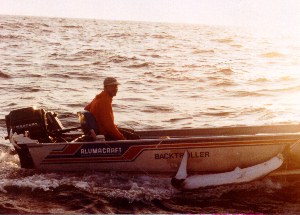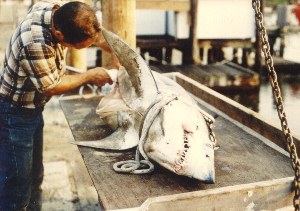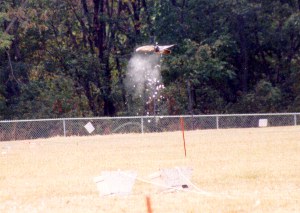How Does a Former Hunter and Fisherman become the Founder of SHARK?
by Steve Hindi, SHARK Founder and President
First published in Animal People and edited by Merritt Clifton, May 1996

I first fished at age five, with my brother Greg, who is one year younger. Each of us caught a perch out of a lake in St. Paul, Minnesota. Fascinated, we watched the two perch swim around in a small bucket until first one and then the other died. I don't remember what happened to their bodies, but I know they were not large enough to eat. Perch are plentiful, and easy to hook, and are therefore considered to be a good species for practice fishing. Many members from both sides of my family were fishers, as well as hunters, trappers, and ranchers. A couple of dead perch didn't rate much concern. Like most children, we learned what we were taught, setting aside whatever qualms we may have felt.
Our mother raised us to care for cats and dogs, and we regularly took in strays, despite housing project rules which forbade it. However, we were told that fish had no feelings, and we killed them with abandon. Our first decade or so were spent pursuing panfish, as they were prevalent around the lakes we were able to walk to. Sometimes family members and friends drove us to other lakes. On a good day we would fill up buckets or stringers of sunfish, crappies, bullheads and perch. Sometimes they were eaten, and sometimes they were simply thrown away. The most important thing was the acquisition: the victory.
Alone Against the Rodeo
Click here to watch the award-winning 2001 30-minute investigative documentary, Alone Against the Rodeo, which tells the story of Steve's efforts to expose rodeo cruelty. The film won the Brigitte Bardot International Award for its hard-hitting story of cruelty and corruption in the world of American rodeos.
In our early teens we also fished for carp. Although they are considered a "trash" species, not recognized as "game," they are much larger and fight much harder. Carp typically were left to suffocate on the shore. We were told this was good for the other fish in the lake, as carp supposedly turned the bottom to mud. Sometimes I would give a fleeting thought to whether these animals suffered as they lay gasping on the shore. Like catfish and bullheads, carp take a long time to suffocate. After a while, we would hit carps' heads with rocks to kill them quickly. Once we brought M-80 firecrackers to the lake. We stuffed one into the gill of a large carp, lit the waterproof fuse, and released him. Seconds later the water erupted in a red spray. When the muddy water cleared, we saw the carp's head, blasted away from his body. I watched tentacles of flesh sway back and forth in the current. Small fish inspected them with curiosity. For some reason we felt bad about this, although no one said anything in particular. We did not do that again. Looking back at it, however, I guess that victim suffered far less than those who suffocated.
In our late teens we got our own cars, and turned our attention to different lakes and larger game fish - trout, bass, walleyes and northern pike. Of these, northerns were my favorite, because of their aggressive nature. Often we bought large sucker minnows as bait. The suckers were hooked just under and to the rear of the dorsal fin, in a way that would allow as much movement as possible, and would maximize their survival time. Some fishers would run the hook through their eyes. The suckers were thrown out and suspended under a bobber, or were held close to the bottom by a lead sinker. The bobber was big enough to prevent the minnow from pulling it underwater, but small enough to be taken down by a larger predator as it grabbed the minnow. Although we were told, and wanted to believe, that fish did not feel fear or pain, we almost always knew when a predator approached the sucker. The bobber would begin to bounce and move; although the sucker wasn't big enough to sink the bobber, his or her panic was obvious. The bobber jerked, pulsed, and slowly dragged across the water as the bigger fish approached. Often the predator would only strike the sucker and let go, probably sensing that something was wrong. We would reel the smaller fish in to find him, or her, often still alive but ripped to shreds.

Steve Hindi, 2006
At one point I decided that live bait fishing was cruel and not particularly "sporting," and I pursued my prey thereafter with artificial lures or dead bait. This, I felt, would be more humane. As time went on, we increasingly often addressed matters of ethics and conservation, at least superficially. Spokespeople for fishing began talking of catch-and-release. This, they assured, would secure both the future of our victims, and the tradition of humans harassing and killing them. In catch-and-release, we would hook our prey, allow them to suffer as they fought for their lives, and then release them, hoping they would survive to endure this torture again. What we never bothered to admit was that any supposed quest for food, our supposed primary objective as hunters, played no part in our new ethic.
Yet we could not admit that the vast majority of us were pulling hooks into the mouths, eyes, tongues, throats and internal organs of animals simply because we loved the feeling of their struggle against our cruelty. At about the same time catch-and-release became popular, there came another move to make fish abuse more "sporting." This time the ethical gurus decided that fishers should use lighter gear to fight our victims. It was of course no accident that the move spawned a whole new avenue for profit. There were smaller reels, lighter lines, and lighter rods made of new materials. New record classifications were developed that gave almost anyone a chance to hold a "world record" because he or she killed a weird-size fish with some weird-class line. Fishing magazines taught anglers new methods to use with ultra-light gear. For me, ultra-light methods were a very successful method of destroying many species of fish.
Of course, using ultra-light gear condemned our victims to more suffering than ever in the name of sportsmanship. We thought it was great. A small fish could be fought not for a couple minutes, but perhaps for a quarter of an hour, half an hour, or more. As someone who invested heavily in ultra-light gear, I was able to in some cases extend my victims' misery for hours. I even wrote articles on the subject that appeared in local fishing magazines. Coming of age As I reached my early twenties, I continued my quest for bigger fish. One goal was to catch a fish over forty pounds. For a Midwestern freshwater fisher, this was not easy. Few Midwestern freshwater species ever top forty pounds. I wanted either a muskie or a Chinook salmon, and for a few years spent plenty of time, effort, and money in both U.S. and Canadian waters, searching for my trophy. When I wasn't fishing, I was either working to make the money I needed to pursue fish, planning my next expedition, or reading up on my obsession. A library book about shark fishing almost immediately convinced me to try it. Over the next few months, I made ready for a trip to the Atlantic Ocean.
At first, my conversion to shark fishing seemed to quell a fairly quiet but nagging voice suggesting that killing animals, especially those much smaller than me, was not completely defensible as a hobby. Many fish species are under incredible pressure from humans, but I told myself, as sport fishers still tell themselves, that commercial fishers do the real damage. Commercial fishers, of course, claim the opposite. In truth, there is a fine, often indistinguishable line between the two factions. We are all guilty, though few who still fish will admit it. In the spring of 1985 I drove to Montauk Point, Long Island, New York. I immediately found that my preparations were completely inadequate. Nevertheless, by a stroke of luck and macho stupidity, I succeeded in killing a seven-and-a-half foot, 230-pound Mako shark, despite of my undersized boat and equipment. My fish story about the one who didn't get away was written up in the New York Daily News.

For the next few years I heard my story retold by those who did not know I was the human participant, and it was a real ego boost. Fishermen love to tell stories, whether their own or someone else's. Every year, the fish became larger and the boat became smaller. In truth, I had ambushed a fish who was merely seeking a meal, and subjected him to five hours of agony before killing him. For some years the mounted shark hung as a trophy on my office wall.
At home were other mounted animal bodies, testimony to my insecurity, insensitivity, and willingness to kill for fun. As I look back, the whole thing seems quite macabre. Over the next few years I went to the ocean at least twice a year, for two or three weeks at a time. I bought a new boat, made for ocean fishing, and named it the One Resolve, because of my determination to hunt and kill a rare thousand-plus-pound great white shark.
I stole the lives of uncounted victims of many species. But what should have been a killer's dream come true was somehow losing its luster over time and death. On occasion we would go night fishing for tuna offshore. Tuna are large, very strong fish, with rigid bodies. Once pulled onto the deck of the boat, they beat their tails incredibly fast and furiously. They can break a fisherman's foot. When the bite was on, the deck could literally be full of tuna struggling for life. In order to keep them still, we simply put a cloth over their exposed eye to block the light and calm them, much as you would calm a horse. This was a problem. Much like a horse? How much like a horse? I wouldn't do this to a horse. Why was I doing this? For years, I managed not to answer that question.
Chumming
There was also the time that sea birds were bothering our lines in the chum slick. A chum slick is a gooey mixture of ground-up fish, dumped into the water to attract sharks. It also attracts birds, who swoop down to pick at bits and pieces of fish. Sometimes birds would hit our lines, or temporarily get their feet caught in the line. One day when the sharks weren't biting, that was more than I was willing to tolerate. One bird was particularly bold, and refused to react to yells, waves or anything else I did to dissuade him. So I shot him. At that close range, he was dead immediately. His body upended, and his legs flailed. While my logical mind knew he was gone, my conscience told me that I had done something rotten, and to finish it. But the shotgun jammed. The next thirty seconds seemed like thirty minutes as the bird's legs kicked and "ran," and slowly came to a halt. It was almost half an hour before his body floated out of sight. I watched almost the entire time, knowing I was the world's biggest asshole, trying desperately and unsuccessfully to convince myself that I had a good reason to do it.
Then my brother and I encountered a baby mako shark next to the boat, in our chum slick. Mako sharks are fearsome-looking, with large gnarly teeth and coal-black eyes that make them look as if always enraged. But this miniature version, of about twenty pounds, was just plain cute, like a lion cub trying to strut his stuff with baby growls and tiny hops, feigning attack. My brother Greg asked if he could catch the baby, and have him mounted. This was a common practice, but one that I abhorred. This was, after all, a baby. From a fisher's view, however, he was also a lot cheaper to mount, and did not require the room a large fish did to display. Initially I refused to allow the capture, but when the baby hung around to gorge on the chum, a sorry version of brotherly love won out. No effort at all was required to capture the baby. Greg stuck a dead hooked mackerel in front of him, he grabbed it, was hooked, and Greg swung him into the boat, into a fish hold. We did not shoot or even hit the baby in the head: that would ruin the mount.
I don't remember how long it took him to die, but it was very long. Every now and then I would open the hatch to see if he was dead yet, and he would look at me. Sharks can move their eyes to a point, and they can and do follow activities around them. I will never forget that baby watching me as I waited for him to die. This was probably the lowest I dropped in my long history of killing. Then came the day that a friend and I hooked into the largest mako shark I ever saw. She looked like an ICBM missile when she jumped, and my friend and I were so fearful that our legs shook. This was going to be the trophy of our lives. For the next two hours we fought and fought just to get the huge animal close to the boat. But a short time after the fish began the familiar circling around the boat that indicated the start of fatigue, the hook pulled out. Probably she had been "foul hooked," meaning hooked in the body somewhere other than the mouth.
Our dreams of a "monster kill" were shattered. We fished the area for the rest of our trip, but without ever so much as seeing our "trophy" again. When we were ready to leave for home, we were still sulking like scolded puppies. I moaned and groaned my disappointment to the marina manager, with whom I had become good friends. His response was not what I expected. He looked me in the eye and said, "Steve, I'm glad you didn't kill that fish." I was so taken aback, I said nothing. He told me that such a large mako was almost certainly a female. He said he recently learned that females had to attain many hundreds of pounds before even reaching the age of giving birth. With the mako population in serious decline, he said, we had to stop killing them. This made sense to me, even if I still wanted that "trophy." But then he said, "I'll tell you the truth, I just don't know how much more of this killing I can take." Oh shit. Now that nagging voice I was hearing for years wasn't just in the back of my mind any more. It was being voiced right in front me, by a friend. I didn't know what to say, except to murmur that I respected his right to his opinion. I didn't say that I was having a tougher and tougher time trying to deny this feeling in myself.
One of the last straws occurred at a most odd time. I was fishing with a friend and working companion named Rick, with whom I had taken a number of successful fishing trips in the past. We hooked a 200-pound mako shark right at the end of the day. The fish jumped repeatedly and fought hard, all of which we should have enjoyed immensely. Having brought the victim to the side of the boat, I made a good shot with my .357 magnum revolver, right on top of his head, resulting in an instant kill. Rick and I brought our victim right up next to the boat, and as was customary, I sank my hunting knife right behind his head to sever the spinal cord. This insured that sharks, who are very tenacious of life, were truly dead. As the beautiful luminescent blue of the mako began to turn to turn gray with death, I turned to Rick and said, "You know, I just don't enjoy this the way I used to." There. I had said it. That nagging feeling that had dogged me for so long now had a voice, and was my own. But things got stranger when Rick, his smile disappearing, said, "You know, I feel the same way." What was my world coming to?
Hegins

I don't know how long I might have been able to ignore my observance that I was doing something indefensible. It might have gone on for years. Fortunately, Hegins, Pennsylvania lay close to the route I took from Chicago to Montauk. On the way to my boat in 1989, I chose to stop and see the infamous Hegins Labor Day pigeon shoot. After witnessing my first pigeon shoot, my perception of my animal trophies was never the same. But I did not quit killing easily. Initially, it never crossed my mind that I would actually stop doing what I had done for three decades. My intention was to stop these vile pigeon shoots, and then go on with the vile things I was doing. I approached many of my hunting and fishing friends for help in fighting pigeon shoots, which as I explained, were not only unethical, but cast all of us "legitimate sportsmen" in a bad light.
With the exception of my brother, none of the great hunting "conservationists" were willing to take any time away from killing to actually try to help animals. It was about a year before I gave up blood sports. God knows how I fought to continue to kill. Leaving blood sports meant accepting a whole new set of values, and eventually coming to terms with owing a debt I could never repay. But after Hegins, it became clear that I would have to try. Greg and I buried our "trophy" victims, including my first shark and the baby mako, in a grave on our family property, next to the graves of beloved nonhuman family members. I donated the One Resolve to the Sea Shepherd Conservation Society.
As I tearfully bade her good-bye, I renamed her the New Resolve, for she would now be used to save lives instead of taking them, to rescue marine animals in trouble, and to patrol for poachers. A few years later, we would even be briefly reunited on the coast of California, while trying to stop Chicago's Shedd Aquarium from capturing dolphins. When I first talked to activists about fishing, at Hegins in 1989, one person asked me, "Would you still fish if they had vocal cords?" I believe the answer in most cases would be no. Fishing is as popular as it is precisely because fish do not have the ability to communicate suffering as readily as cats, dogs, cows, or other mammals. But I know they suffer tremendously, just as we would if subjected to such horrendous treatment. While many people may at first be taken aback at the mere suggestion that fish can suffer, I believe society can grasp the concept. And if we can make people feel for those who cannot cry out their suffering, how much more will they feel for those who can?




